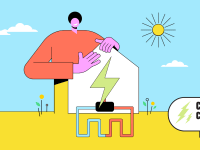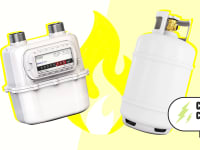Products are chosen independently by our editors. Purchases made through our links may earn us a commission.
As many of us consider ways to cut our carbon footprint in and around the home with the hope of slowing climate change, the idea of finding alternative energy solutions that don’t rely on fossil fuels is more and more appealing.
While some people might consider retrofitting their homes with geothermal heat pumps for heating and cooling purposes, others may install solar panels that can power their electrical system.
Still others might find that they have the ability to power their homes using a small home wind turbine system. Though we’re all familiar with windmills and wind turbines, and you’ve probably driven past a wind farm at one point or another, along the highway or out at sea, you may not know that even individual households can maximize wind generation by installing a small wind turbine to generate electricity for the home.
But, you’ve first got to ask yourself the question, “Is a home wind turbine system right for me?” If you haven’t considered wind energy as a power source, here’s what you’ll want to know.
What is wind?
This is one of those questions most of us never even think about, but unless you're an armchair meteorologist, you have probably never considered where wind comes from.
We all know that wind is the reason that our umbrellas turn inside out during high wind or a blustery storm, and that wind was Dorothy’s primary mode of transportation to Oz. But what is it?
Wind is the movement of air caused by the uneven heating of the Earth by the sun. It’s likely you’ve heard your local weather reporter use terms like easterlies, westerlies, and trade winds; these are just a few of the kinds of wind patterns that flow through our atmosphere, carrying warmer or colder air to different parts of the globe.
A wind’s power and velocity is measured in terms of wind shears, which calculate the speed and direction of the wind.
Humans have put wind to use for thousands of years: We’ve used it to better understand the climate and the Earth’s ecology, and to determine travel patterns around our planet for centuries.
We have also been able to harness wind for energy, using windmills or turbines that convert the wind’s kinetic energy into electricity. This is energy efficiency at its best.
How do windmills and wind turbines work?
Wind turbines convert wind's energy into mechanical power that can be used to run a generator to produce clean electricity without relying on fossil fuels; it’s otherwise known as renewable energy.
The blades of a wind turbine are designed to capture the maximum amount of kinetic energy from the wind, which spins them.
As the blades turn, a shaft that is connected to a generator converts the captured energy into electricity that can be stored in a battery or connected to the utility grid. The larger and more powerful the turbine, the greater the electricity output.
Home wind turbine systems generally consist of a rotor, a generator or alternator mounted on a frame, a tail, and a tower. These components are then connected by wiring to the balance of system components, controllers and inverters, which connect this captured energy to your electrical grid.
If you choose to use a windmill off the grid, a battery that stores your generated power will also be necessary as part of your balance of system. Additionally, a home wind turbine system may also be connected with solar panels to further support life off the grid. These are called solar wind hybrid systems.
Buy now at Missouri Wind and Solar
Will a home wind turbine system reduce my carbon emissions?
If reducing your carbon footprint is a goal, a small home wind turbine system is an excellent choice to consider.
Wind turbine power, like solar power, is an infinitely renewable form of energy, it does not require any fuel for operation, and it doesn’t generate any harmful air or water pollution. Wind energy production doesn’t create greenhouse gasses, nor are there any toxic or radioactive waste byproducts emitted from the energy conversion process, making it one of the cleanest energy sources available to us.
A home wind turbine system can be used to partially or fully offset your electricity needs, depending on your usage and what you can create in terms of usable power.
Even if you can’t commit to a large system that will power your entire property, a smaller one will easily provide power for some of your electricity needs, or it can be used in tandem with things like solar panels to obtain your electricity by other, non-fossil fuel methods.
How do I know if my property is in an appropriate location for a home wind turbine system?
According to the U.S. Department of Energy (DOE), there are three significant criteria that factor into whether your home is ideally situated for a small wind electric system.
1. Do you live in an area of the United States where there is enough wind?
This sounds simple, but since wind is crucial to powering turbines, it’s important to know how much consistent wind your property gets.
It’s also important to know that different spots on your property may be better suited for a wind tower than others.
You can consult a wind resource map like the ones provided by the National Renewable Energy Library, or you can reach out to your local airport for information on local wind speeds.
2. Are you zoned for a windmill?
Windmills need a lot of height for both safety and maximum energy output, but many residential areas are not zoned for structures taller than the average house.
When determining how tall your windmill needs to be, the general rule of thumb is to install a wind turbine on a tower with the bottom of the rotor blades at least 30 feet above any obstacle that is within 300 feet of the tower.
So, if your zoning laws (or, perhaps equally important, your neighbors) don’t allow for tall structures like a windmill, you may need to reconsider.
3. Do you have the right amount of acreage?
Generally, installing a wind turbine is only recommended for homes on property larger than one acre. You need to consider height clearance, to maximize the height—and therefore the maximum output—of the structure, and, in case of icy conditions, to ensure that any snow or ice will not be thrown off the blades, causing damage or harm to others.
What does a home wind turbine system cost to install?
As with many clean energy options, there are significant up-front costs to installing a home wind turbine system, but if the installation of this kind of system is looked at as a long-term investment, it will certainly pay off.
There will be up-front costs related to local zoning, permitting, and utility interconnection, which will all vary depending on where you live.
As far as the costs to install the system itself, the DOE stated that in 2021, the average cost to install a small wind system was $5,120 for every kilowatt of generating capacity. It becomes more cost effective as the size of the turbine’s rotor increases.
Per the DOE, if the typical home uses approximately 10,649 kilowatt-hours (kWh) per year, a wind turbine rated in the range of 5 kW to 15 kW would be required to provide the energy needed for this demand.
By this math, you’re looking at anywhere from $25,600 to upwards of $77,000 for the installation of a home wind turbine system.
There are also currently several tax incentives and credits available to those who are considering installing a home wind turbine system, featuring tax credits of up to 30% for certain residential wind turbine installation projects.
More detailed information regarding the government’s tax credit program, called the Residential Renewable Energy Tax Credit, can be found on the DOE website.
Though there are several caveats to consider before installing a home wind turbine system, under the right conditions, they provide a long-term solution to your energy needs, in addition to being an effective way to reduce your carbon consumption.


